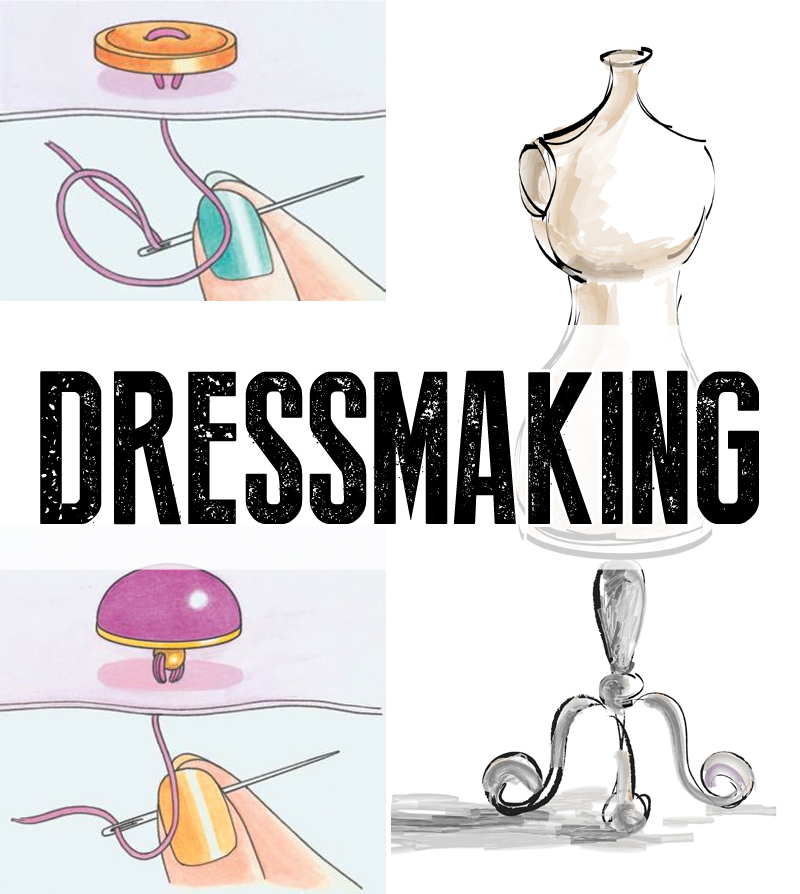Dressmaking Techniques

Dressmaking Techniques
Discover all the essential techniques to take your dressmaking to professional level
How to sew a two-hole button




Secure the thread and bring the needle to the surface at the position of the button and bring it through the button from the back.
Take the needle down through the other hole and through the fabric, leaving a small gap between the button and the fabric.
Repeat the above to work a few stitches through the button holes. Then take the needle around the threads between the fabric and the button to form a shank.
To finish, work on the wrong side and make a couple of stitches through the threads to secure.
How to sew a four hole button




Secure the thread and bring the needle to the surface at the position of the button and bring it through the button from the back.
Take the needle down through the other hole and through the fabric, leaving a small gap between the button and the fabric.
Repeat the above to work a few stitches through the button holes. Then take the needle around the threads between the fabric and the button to form a shank.
To finish, work on the wrong side and make a couple of stitches through the threads to secure.
How to sew a button with a shank




Secure the thread and bring the needle to the surface at the position of the button and bring it through the button from the back.
Take the needle down through the other hole and through the fabric, leaving a small gap between the button and the fabric.
Repeat the above to work a few stitches through the button holes. Then take the needle around the threads between the fabric and the button to form a shank.
To finish, work on the wrong side and make a couple of stitches through the threads to secure.
How to stitch woven skirts to knit tops




Secure the thread and bring the needle to the surface at the position of the button and bring it through the button from the back.
Take the needle down through the other hole and through the fabric, leaving a small gap between the button and the fabric.
Repeat the above to work a few stitches through the button holes. Then take the needle around the threads between the fabric and the button to form a shank.
To finish, work on the wrong side and make a couple of stitches through the threads to secure.
How to slip stitch a hem




Secure the thread and bring the needle to the surface at the position of the button and bring it through the button from the back.
Take the needle down through the other hole and through the fabric, leaving a small gap between the button and the fabric.
Repeat the above to work a few stitches through the button holes. Then take the needle around the threads between the fabric and the button to form a shank.
To finish, work on the wrong side and make a couple of stitches through the threads to secure.
How to sew with stretch fabrics
Follow our top tips and create beautiful garments with stretch fabrics!




Secure the thread and bring the needle to the surface at the position of the button and bring it through the button from the back.
Take the needle down through the other hole and through the fabric, leaving a small gap between the button and the fabric.
Repeat the above to work a few stitches through the button holes. Then take the needle around the threads between the fabric and the button to form a shank.
To finish, work on the wrong side and make a couple of stitches through the threads to secure.
How to sew with slippery fabrics




Secure the thread and bring the needle to the surface at the position of the button and bring it through the button from the back.
Take the needle down through the other hole and through the fabric, leaving a small gap between the button and the fabric.
Repeat the above to work a few stitches through the button holes. Then take the needle around the threads between the fabric and the button to form a shank.
To finish, work on the wrong side and make a couple of stitches through the threads to secure.
How to sew with pile fabrics




Secure the thread and bring the needle to the surface at the position of the button and bring it through the button from the back.
Take the needle down through the other hole and through the fabric, leaving a small gap between the button and the fabric.
Repeat the above to work a few stitches through the button holes. Then take the needle around the threads between the fabric and the button to form a shank.
To finish, work on the wrong side and make a couple of stitches through the threads to secure.
How to sew a double-fold hem




Secure the thread and bring the needle to the surface at the position of the button and bring it through the button from the back.
Take the needle down through the other hole and through the fabric, leaving a small gap between the button and the fabric.
Repeat the above to work a few stitches through the button holes. Then take the needle around the threads between the fabric and the button to form a shank.
To finish, work on the wrong side and make a couple of stitches through the threads to secure.
How to make a thread chain




Secure the thread and bring the needle to the surface at the position of the button and bring it through the button from the back.
Take the needle down through the other hole and through the fabric, leaving a small gap between the button and the fabric.
Repeat the above to work a few stitches through the button holes. Then take the needle around the threads between the fabric and the button to form a shank.
To finish, work on the wrong side and make a couple of stitches through the threads to secure.
How to make a corded button loop




Secure the thread and bring the needle to the surface at the position of the button and bring it through the button from the back.
Take the needle down through the other hole and through the fabric, leaving a small gap between the button and the fabric.
Repeat the above to work a few stitches through the button holes. Then take the needle around the threads between the fabric and the button to form a shank.
To finish, work on the wrong side and make a couple of stitches through the threads to secure.
How to insert a concealed zip




Secure the thread and bring the needle to the surface at the position of the button and bring it through the button from the back.
Take the needle down through the other hole and through the fabric, leaving a small gap between the button and the fabric.
Repeat the above to work a few stitches through the button holes. Then take the needle around the threads between the fabric and the button to form a shank.
To finish, work on the wrong side and make a couple of stitches through the threads to secure.
How to stitch a French seam




Secure the thread and bring the needle to the surface at the position of the button and bring it through the button from the back.
Take the needle down through the other hole and through the fabric, leaving a small gap between the button and the fabric.
Repeat the above to work a few stitches through the button holes. Then take the needle around the threads between the fabric and the button to form a shank.
To finish, work on the wrong side and make a couple of stitches through the threads to secure.
How to create gathering stitches




Secure the thread and bring the needle to the surface at the position of the button and bring it through the button from the back.
Take the needle down through the other hole and through the fabric, leaving a small gap between the button and the fabric.
Repeat the above to work a few stitches through the button holes. Then take the needle around the threads between the fabric and the button to form a shank.
To finish, work on the wrong side and make a couple of stitches through the threads to secure.






